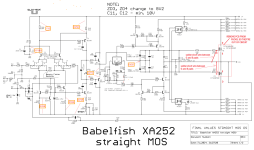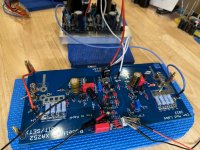I’m wondering why I haven’t got any burnt parts sofar. I frequently clip the amp (easy visible for me because of the integrated clipping indicator). In the weekend, I clipped the amp that hard, that the speaker protection was triggered and disconnected the speakers. After shutting down the amp’s, visual inspection and restarting, all is fine again.
The only difference with the standard BOM, are the much higher Vce rated to126 VAS and driver bjt’s.
The only difference with the standard BOM, are the much higher Vce rated to126 VAS and driver bjt’s.
Hi ZM,
I‘ve noticed that there have been a number of alterations to the schematic ( two LEDs and two resistors around BD139/BD140 and the MOSFET replacing the 22v zener on the Input to the CCS) and was hoping that there is an Updated schematic. I‘ve seen Post #2437. is this the latest and greatest or is something in the Wings?
I‘ve noticed that there have been a number of alterations to the schematic ( two LEDs and two resistors around BD139/BD140 and the MOSFET replacing the 22v zener on the Input to the CCS) and was hoping that there is an Updated schematic. I‘ve seen Post #2437. is this the latest and greatest or is something in the Wings?
there are practically two changes in pcbs being sent ......
as far as I remember , there are no sent pcbs with 2 LED change; as I said - working on last gen of pcbs with additional buffer stage protection
so, just chill; make change noted in post #2573
future pcbs will be fully documented here
- 5pcs of rail resistors in place of (initial) 3
- BS170 cascode mosfet in place of upper zener, as protection for LT3092
as far as I remember , there are no sent pcbs with 2 LED change; as I said - working on last gen of pcbs with additional buffer stage protection
so, just chill; make change noted in post #2573
future pcbs will be fully documented here
Important revision of protection circuit:
Soldering resistor in parallel to diode in Optocoupler (OK1, OK2, pins 1-2), practically in parallel to LM385-1V2 (V1, V2), thus increasing protection threshold from intended 10Apeak;
So, choose - 100R across OK pins 1-2 shall elevate threshold by 50%; 47R across OK pins 1-2 shall elevate threshold by 100%, not-fitting both OK optocouplers and V1,V2 LM385 and TH1 Thyristor means no current limiting of OS at all; that option also viable
Said resistors can be anything - from tiny smd to 0207 size; power is negligible there
Reminder - all zener diodes right from Q3, Q4 (looking at schm in post #1) - value in range of 8V2 to 12V, whatever easiest to grab
Hope it'll help to contain Gray Smoke in bottle.
Diodes..
ZM's Diodes Of Death.
Smoke on the water and fire in the living room...
Does this apply for ALL versions?
My latest version, the MOS did run into protection but did not smoke and now is playing well. The SIT version... well...
Do we all need this change?
Last edited:
My amp (MOSFET version) has already been playing for a year. Usually 8-10 hours a day, Monday to Friday, less over weekend. Off in hot summer days. No issues whatsoever. Do you think it is still worth adding this little modification?
Last edited:
Do we all need this change?
you especially

it is still worth
yes
The thing is.... it seems like the only time this happens is when I plug into into the Maggies, which at 83 db/w are particularly mean.
I'm not about to take the amp apart now that it's working. So, I might just use it on more efficient speakers. Like 90db/w.
It seems like those of you running into efficient speakers have never run into this problem.
So, when in Rome, do as the Romans. I might just look for a pair of 95db/w or so speakers.... Nothing like running A2 into a 95 db/w speaker. It will give Nelson's notion about the First Watt some uber validity.
SO... given that I will use this amp with more efficient speakers... will the amp sound better or is it just a prevention when it runs out of power? If so, what will this power level be? 50watts? 100 watts? The XA25 seems to be underrated...
I'm not about to take the amp apart now that it's working. So, I might just use it on more efficient speakers. Like 90db/w.
It seems like those of you running into efficient speakers have never run into this problem.
So, when in Rome, do as the Romans. I might just look for a pair of 95db/w or so speakers.... Nothing like running A2 into a 95 db/w speaker. It will give Nelson's notion about the First Watt some uber validity.
SO... given that I will use this amp with more efficient speakers... will the amp sound better or is it just a prevention when it runs out of power? If so, what will this power level be? 50watts? 100 watts? The XA25 seems to be underrated...
Last edited:
just a prevention when it runs out of power
just a prevention to avoid running out of power .... and letting gray smoke out
When the protection kicks in, grey smoke from output stage is prevented. But, driver stage, is via caps and zener diodes in output stage loaded with speaker load! Resulting in quite some power dissipation in the driver stage.
A very fast speaker protection can save the day. Why: simulation and experience showed me that when protection is active, the speaker output node is at a couple of volts, triggering speaker protection.
This also means if the caps in the feedback network are bypassed (need to be in balanced mode), this voltage is multiplied by ~10, resulting in about rail to rail voltage over 1 of the drivers.
Conclusion:
1. most robustness is with caps in feedback network NOT bypassed = SE-mode.
2. fast speaker protection adds robustness to prevent blowing driver stage.
Current limitation in the driver stage could be a solution.
A very fast speaker protection can save the day. Why: simulation and experience showed me that when protection is active, the speaker output node is at a couple of volts, triggering speaker protection.
This also means if the caps in the feedback network are bypassed (need to be in balanced mode), this voltage is multiplied by ~10, resulting in about rail to rail voltage over 1 of the drivers.
Conclusion:
1. most robustness is with caps in feedback network NOT bypassed = SE-mode.
2. fast speaker protection adds robustness to prevent blowing driver stage.
Current limitation in the driver stage could be a solution.
Thanks for that explanation 🙏
I put 220R across OK1 and OK2. Does the lower 100R increase the ceiling over 220R?
I put 220R across OK1 and OK2. Does the lower 100R increase the ceiling over 220R?
Powered up output FET-Less, no magic smoke!
Hi ZM,
I attached your annotated schematic with my measured values.
Both amp boards measured the same.
Voltage across R19 and R20 are considerably off from yours
Hi ZM,
I attached your annotated schematic with my measured values.
Both amp boards measured the same.
Voltage across R19 and R20 are considerably off from yours
- PSU during measurements was +/-31V5
- Input shorted
- JP1 open
Attachments
Last edited:
Vunce,
Voltages look fine.
Look here: https://www.diyaudio.com/community/...belfish-xa252-set.373443/page-98#post-7652296
Voltages look fine.
Look here: https://www.diyaudio.com/community/...belfish-xa252-set.373443/page-98#post-7652296
@Zen what is the likelihood of just the resistor burning. I removed the board and from basic measuring resistance, none of the active parts seem to have failed, even the optocouplers seem OK. I was expecting mayhem! I wonder if I switched it off in time? My speakers were protected by the mosfet based protection switch which would have unloaded the amp.
Am I the luckiest guy with a smoking amp?
I guess only one real way to find out....
dB
Am I the luckiest guy with a smoking amp?
I guess only one real way to find out....
dB
- Home
- Amplifiers
- Pass Labs
- Babelfish XA252 / Babelfish XA252 SIT / Babelfish XA252 SET


